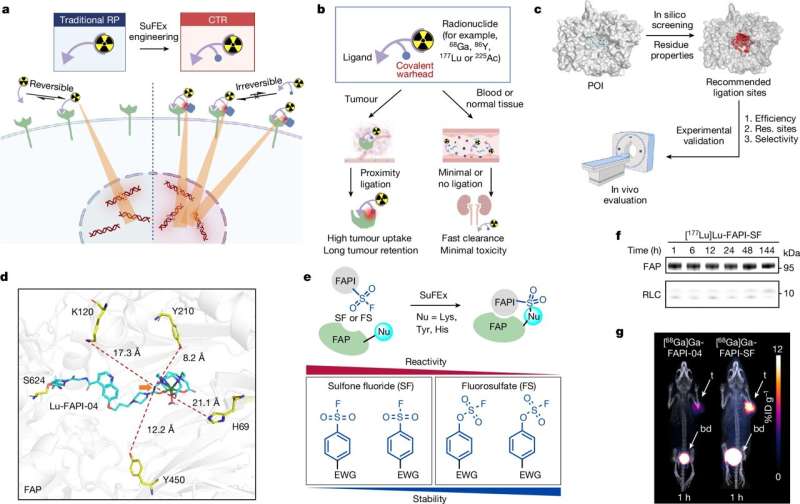This article has been reviewed according to Science X's editorial process and policies. Editors have highlighted the following attributes while ensuring the content's credibility:
fact-checked
peer-reviewed publication
trusted source
proofread
New study highlights potential of covalent radioligands in cancer treatment

Prof. Liu Zhibo's team from Peking University (PKU)'s College of Chemistry and Molecular Engineering, along with collaborators, recently published a paper titled "Covalent targeted radioligands potentiate radionuclide therapy" in Nature. This marks the journal's first publication on radionuclide therapy since 1977. (Radionuclides are radioactive forms of elements.)
The study provides a hopeful perspective on treating metastatic cancer, which is responsible for the majority of deaths from all cancers. In 2020, cancer led to nearly 10 million deaths, accounting for 1 in 6 deaths worldwide, according to the WHO.
In 2020, the Journal of Nuclear Medicine defined targeted radionuclide therapy as a (promising) treatment that "delivers ionizing radiation to tumors in a targeted manner, reducing the dose that healthy tissues are exposed to."
How does it work?
The ionizing radiation emitted by radioactive substances attached to the carrier destroys cancer cells by damaging their DNA, leading to the reduction of tumors.
The efficacy of TRT can be measured by three dimensions: tumor targeting, quick blood clearance, and adequate tumor retention, as stated in the research paper.
To simplify, effective radionuclides, which act as "warheads" against cancer, need to be quickly cleared from the bloodstream to prevent toxicity. At the same time, they should remain in malignant tumors for a sufficient period to target and destroy cancer cells, considering that most therapeutic radionuclides have half-lives ranging from three to 10 days. This can be a delicate balancing act.
In the study, the PKU team incorporated a sulfur (VI) fluoride exchange (SuFEx) chemistry-based linker into radiopharmaceuticals (radioactive drugs used in cancer treatment) to enhance precise tumor targeting, quick elimination from the bloodstream, and sufficient retention in the tumor site.
The strategy was applied to a fibroblast activation protein (FAP) inhibitor (FAPI), resulting in more than 80% covalent binding to the protein with minimal dissociation for six days. (FAP is a protein found in tumors.)
In mice, the SuFEx-engineered FAPI showed a 257% increase in tumor uptake compared to the original FAPI, and improved tumor retention by 13 times. (Here, uptake refers to how quickly tumors absorb radiopharmaceuticals.) The uptake in healthy tissues was rapidly cleared.
In a pilot imaging study, this approach detected more tumor lesions in cancer patients compared to other methods. SuFEx-engineered FAPI also effectively accomplished targeted β- and α- radionuclide therapy, leading to almost complete tumor regression in mice.
Given the wide range of proteins that could potentially be linked to SuFEx warheads, there is a possibility of adapting this approach to target other types of cancer.
More information: Xi-Yang Cui et al, Covalent targeted radioligands potentiate radionuclide therapy, Nature (2024). DOI: 10.1038/s41586-024-07461-6





















